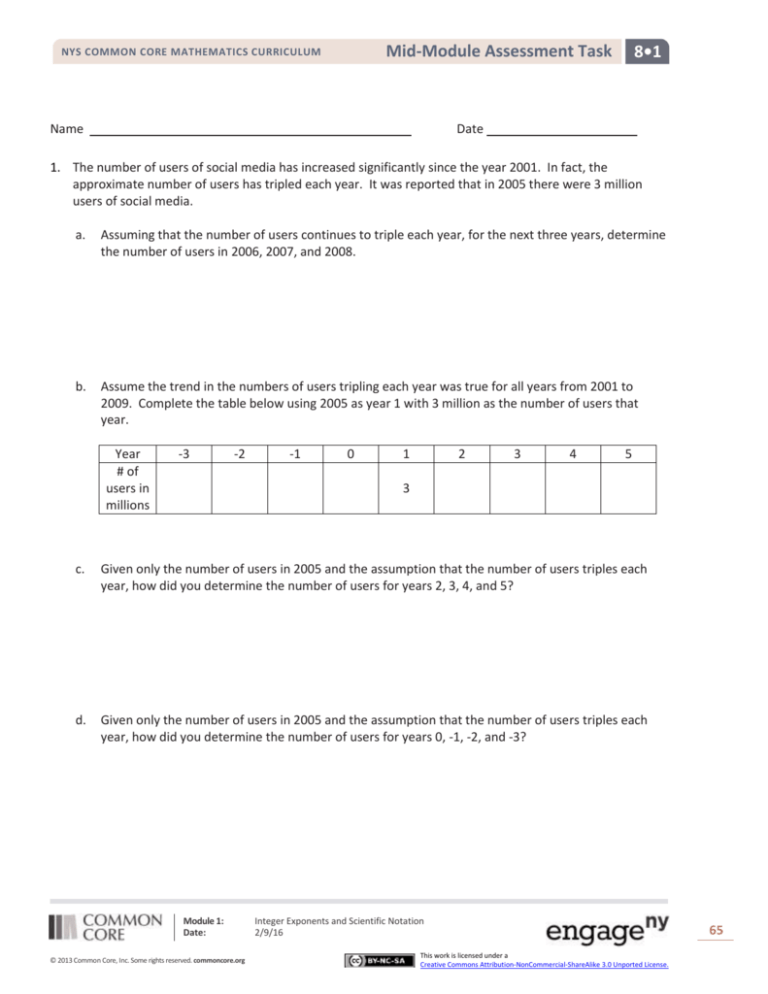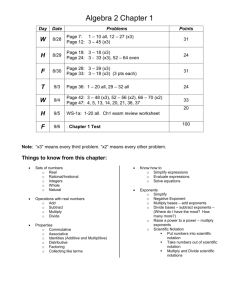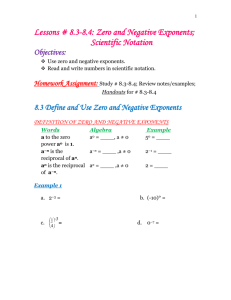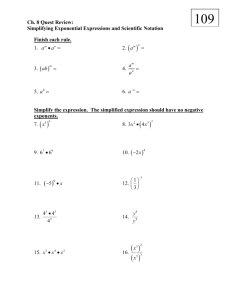
Mid-Module Assessment Task
NYS COMMON CORE MATHEMATICS CURRICULUM
Name
8•1
Date
1. The number of users of social media has increased significantly since the year 2001. In fact, the
approximate number of users has tripled each year. It was reported that in 2005 there were 3 million
users of social media.
a.
Assuming that the number of users continues to triple each year, for the next three years, determine
the number of users in 2006, 2007, and 2008.
b.
Assume the trend in the numbers of users tripling each year was true for all years from 2001 to
2009. Complete the table below using 2005 as year 1 with 3 million as the number of users that
year.
Year
# of
users in
millions
-3
-2
-1
0
1
2
3
4
5
3
c.
Given only the number of users in 2005 and the assumption that the number of users triples each
year, how did you determine the number of users for years 2, 3, 4, and 5?
d.
Given only the number of users in 2005 and the assumption that the number of users triples each
year, how did you determine the number of users for years 0, -1, -2, and -3?
Module 1:
Date:
© 2013 Common Core, Inc. Some rights reserved. commoncore.org
Integer Exponents and Scientific Notation
2/9/16
This work is licensed under a
Creative Commons Attribution-NonCommercial-ShareAlike 3.0 Unported License.
65
NYS COMMON CORE MATHEMATICS CURRICULUM
Mid-Module Assessment Task
8•1
t ³ -3.
e.
Write an equation to represent the number of users in millions, 𝑁, for year, t,
f.
Using the context of the problem, explain whether or not the formula, 𝑁 = 3𝑡 would work for
finding the number of users in millions in year 𝑡, for all t ≤ 0.
g.
Assume the total number of users continues to triple each year after 2009. Determine the number
of users in 2012. Given that the world population at the end of 2011 was approximately 7 billion, is
this assumption reasonable? Explain your reasoning.
Module 1:
Date:
© 2013 Common Core, Inc. Some rights reserved. commoncore.org
Integer Exponents and Scientific Notation
2/9/16
This work is licensed under a
Creative Commons Attribution-NonCommercial-ShareAlike 3.0 Unported License.
66
Mid-Module Assessment Task
NYS COMMON CORE MATHEMATICS CURRICULUM
8•1
2. Let 𝑚 be a whole number.
a.
Use the properties of exponents to write an equivalent expression that is a product of unique
primes, each raised to an integer power.
621 ∙ 107
307
b.
Use the properties of exponents to prove the following identity:
63𝑚 ∙ 10𝑚
= 23𝑚 ∙ 32𝑚
30𝑚
c.
What value of 𝑚 could be substituted into the identity in part (b) to find the answer to part (a)?
Module 1:
Date:
© 2013 Common Core, Inc. Some rights reserved. commoncore.org
Integer Exponents and Scientific Notation
2/9/16
This work is licensed under a
Creative Commons Attribution-NonCommercial-ShareAlike 3.0 Unported License.
67
NYS COMMON CORE MATHEMATICS CURRICULUM
Mid-Module Assessment Task
8•1
3.
a.
Jill writes 23 ∙ 43 = 86 and the teacher marked it wrong. Explain Jill’s error.
b.
Find 𝑛 so that the number sentence below is true:
23 ∙ 43 = 23 ∙ 2𝑛 = 29
c.
Use the definition of exponential notation to demonstrate why 23 ∙ 43 = 29 is true.
d.
You write 75 ∙ 7−9 = 7−4. Keisha challenges you, “Prove it!” Show directly why your answer is
correct without referencing the Laws of Exponents for integers, i.e., 𝑥 𝑎 ∙ 𝑥 𝑏 = 𝑥 𝑎+𝑏 for positive
numbers 𝑥 and integers 𝑎 and 𝑏.
Module 1:
Date:
© 2013 Common Core, Inc. Some rights reserved. commoncore.org
Integer Exponents and Scientific Notation
2/9/16
This work is licensed under a
Creative Commons Attribution-NonCommercial-ShareAlike 3.0 Unported License.
68
NYS COMMON CORE MATHEMATICS CURRICULUM
Mid-Module Assessment Task
8•1
A Progression Toward Mastery
Assessment
Task Item
1
a–d
8.EE.1
e–g
8.EE.1
STEP 1
Missing or incorrect
answer and little
evidence of
reasoning or
application of
mathematics to
solve the problem.
STEP 2
Missing or incorrect
answer but
evidence of some
reasoning or
application of
mathematics to
solve the problem.
STEP 3
A correct answer
with some evidence
of reasoning or
application of
mathematics to
solve the problem,
or an incorrect
answer with
substantial
evidence of solid
reasoning or
application of
mathematics to
solve the problem.
STEP 4
A correct answer
supported by
substantial
evidence of solid
reasoning or
application of
mathematics to
solve the problem.
Student answered 0–1
parts of (a) – (d)
correctly.
Student was able to
complete the table for at
least values of 0–5 for
part (b). Student was
unable to respond to
questions or left items
blank.
Student answered 2–3
parts of (a) – (d)
correctly.
Student was able to
complete the table in
part (b) correctly for 5 or
more entries, including
at least one value on
each side of the value
given for year 1.
Student provided a
limited expression of
their reasoning in parts
(c) and (d).
Student answered 3–4
parts of (a) – (d)
correctly.
Student provided correct
answers with some
reasoning for making
calculations. OR
Student had a few
miscalculations, but
provided substantial
reasoning with proper
use of grade-level
vocabulary.
Student answered all
parts of (a) – (d)
correctly.
Student provided solid
reasoning for making
calculations with proper
use of grade-level
vocabulary.
Student answered 0–1
parts of (e) – (g)
correctly. Student was
unable to relate the
pattern in the problem
to exponential growth.
Student answered 1–2
parts of (e) – (g)
correctly. Student was
able to relate the pattern
in the problem to
exponential growth by
writing an equation.
Student justifications
were incomplete.
Student answered 2–3
parts of (e) – (g)
correctly. Equation
given was correct AND
student was able to
answer questions, but
justifications were
incomplete. OR
The equation given
related the pattern to
exponential growth, but
was incomplete or
contained a minor error
AND student was able to
answer questions using
solid reasoning based on
the information
provided.
Student answered all
parts of (e) – (g)
correctly.
Student justified
answers AND made
accurate conclusions
based on the
information provided in
the problem. Student
was able to explain
limitations of equation
when looking ahead in
time and back in time.
Module 1:
Date:
© 2013 Common Core, Inc. Some rights reserved. commoncore.org
Integer Exponents and Scientific Notation
2/9/16
This work is licensed under a
Creative Commons Attribution-NonCommercial-ShareAlike 3.0 Unported License.
69
NYS COMMON CORE MATHEMATICS CURRICULUM
2
a
8.EE.1
b–c
8.EE.1
3
a
8.EE.1
b
8.EE.1
c
8.EE.1
Mid-Module Assessment Task
8•1
Student answered
incorrectly. No evidence
of use of properties of
exponents.
Student answered
incorrectly. Properties
of exponents were used
incorrectly.
Student answered
correctly. Some
evidence of use of
properties of exponents
is shown in calculations.
Student answered
correctly. Student
provided substantial
evidence of the use of
properties of exponents
to simplify the
expression to distinct
primes.
Student answered parts
(b) – (c) incorrectly. No
evidence of use of
properties of exponents.
Student answered parts
(b) – (c) incorrectly.
Properties of exponents
were used incorrectly.
Student answered part
(b) AND/OR part (c)
correctly.
Some evidence of use of
properties of exponents
is shown in calculations.
Student answered both
parts (b) AND (c)
correctly.
Student provided
substantial evidence of
the use of properties of
exponents to prove the
identity.
Student stated that Jill’s
response was correct OR
student was unable to
identify the mistake and
provided no additional
information.
Student stated that Jill’s
answer was incorrect.
Student was unable to
identify mistake of
multiplying unlike bases.
Student may have used
what they know about
exponential notation to
multiply numbers to
show the answer was
incorrect.
Student identified Jill’s
error as “multiplied
unlike bases”.
Student identified Jill’s
error as “multiplied
unlike bases”.
Student provided a
thorough explanation as
to how unlike bases can
be rewritten so that
properties of exponents
can be used properly.
Student was unable to
identify the correct value
for 𝑛.
Student correctly
answered 𝑛 = 6.
No explanation was
provided as to why their
answer is correct.
Student correctly
answered 𝑛 = 6.
Student stated that
43 = 26 with little or no
explanation.
Student correctly
answered 𝑛 = 6.
Student clearly showed
that 43 is equivalent to
26.
Student used the
definition of exponential
notation to rewrite 43 as
4 x 4 x 4. Student was
unable to complete the
problem.
Student multiplied 43 to
get 64 AND was able to
rewrite it as a number
with a base of 2, but had
the wrong exponent.
Student rewrote 43 as 26,
then used the first
property of exponents to
show that the answer
was correct.
Student correctly
rewrote 43 as 26.
Student used definition
of exponential notation
to rewrite each number
as repeated
multiplication. Student
clearly showed how/why
the exponents are added
to simplify such
expressions.
Module 1:
Date:
© 2013 Common Core, Inc. Some rights reserved. commoncore.org
Integer Exponents and Scientific Notation
2/9/16
This work is licensed under a
Creative Commons Attribution-NonCommercial-ShareAlike 3.0 Unported License.
70
NYS COMMON CORE MATHEMATICS CURRICULUM
d
8.EE.1
Student may have been
able to rewrite 7-9 as a
fraction, but was unable
to operate with
fractions.
Module 1:
Date:
© 2013 Common Core, Inc. Some rights reserved. commoncore.org
Mid-Module Assessment Task
Student was unable to
show why part (d) was
correct, but may have
used a property of
exponents to state that
the given answer was
correct.
Student answered part
(d), but misused or left
out definitions in
explanations and proofs.
8•1
Student answered part
(d) correctly AND used
definitions and
properties to thoroughly
explain and prove
answer. Answer showed
strong evidence that
student understands
exponential notation
AND can use the
properties of exponents
proficiently.
Integer Exponents and Scientific Notation
2/9/16
This work is licensed under a
Creative Commons Attribution-NonCommercial-ShareAlike 3.0 Unported License.
71
NYS COMMON CORE MATHEMATICS CURRICULUM
Module 1:
Date:
© 2013 Common Core, Inc. Some rights reserved. commoncore.org
Mid-Module Assessment Task
8•1
Integer Exponents and Scientific Notation
2/9/16
This work is licensed under a
Creative Commons Attribution-NonCommercial-ShareAlike 3.0 Unported License.
72
NYS COMMON CORE MATHEMATICS CURRICULUM
Module 1:
Date:
© 2013 Common Core, Inc. Some rights reserved. commoncore.org
Mid-Module Assessment Task
8•1
Integer Exponents and Scientific Notation
2/9/16
This work is licensed under a
Creative Commons Attribution-NonCommercial-ShareAlike 3.0 Unported License.
73
NYS COMMON CORE MATHEMATICS CURRICULUM
Module 1:
Date:
© 2013 Common Core, Inc. Some rights reserved. commoncore.org
Mid-Module Assessment Task
8•1
Integer Exponents and Scientific Notation
2/9/16
This work is licensed under a
Creative Commons Attribution-NonCommercial-ShareAlike 3.0 Unported License.
74
NYS COMMON CORE MATHEMATICS CURRICULUM
Module 1:
Date:
© 2013 Common Core, Inc. Some rights reserved. commoncore.org
Mid-Module Assessment Task
8•1
Integer Exponents and Scientific Notation
2/9/16
This work is licensed under a
Creative Commons Attribution-NonCommercial-ShareAlike 3.0 Unported License.
75









